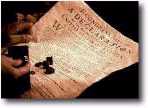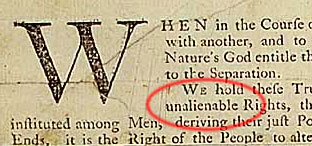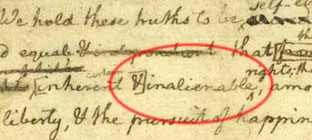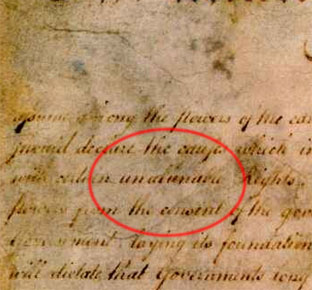The Declaration of Independence
The Want, Will, and Hopes of the People

Unalienable / Inalienable

Dunlap Broadside

Jefferson's handwriting

Parchment copy
The question is often asked, "Is the word in the Declaration of Independence unalienable or is it inalienable?"
The final version of the Declaration uses the word "unalienable." Some earlier drafts used the word "inalienable," which is the term our modern dictionaries prefer. The two words mean precisely the same thing.
According to The American Heritage Guide to Contemporary Usage and Style from Houghton Mifflin Company:
The unalienable rights that are mentioned in the Declaration of Independence could just as well have been inalienable, which means the same thing. Inalienable or unalienable refers to that which cannot be given away or taken away.
Here is a listing of known versions of the Declaration, showing which word is used:
| The Declaration on parchment, now in the Department of State | unalienable |
| The Declaration as written out in the corrected Journal | unalienable |
| The Declaration as printed by Dunlap under the order of Congress | unalienable |
| The draft of the Declaration in the handwriting of Jefferson now in The American Philosophical Society, in Philadelphia | inalienable |
| The Declaration in the handwriting of Jefferson now in the New York Public Library | inalienable |
| The draft of the Declaration in the handwriting of Jefferson now in the Massachusetts Historical Society, in Boston | inalienable |
| The copy in the handwriting of John Adams of the "Rough draught" of the Declaration, now at the Massachusetts Historical Society. | unalienable |
In a footnote in "The Declaration of Independence: A Study in the History of Political Ideas" by Carl Lotus Becker, published 1922, we learn:
The Rough Draft reads "[inherent &] inalienable." There is no indication that Congress changed "inalienable" to "unalienable"; but the latter form appears in the text in the rough Journal, in the corrected Journal, and in the parchment copy. John Adams, in making his copy of the Rough Draft, wrote " unalienable." Adams was one of the committee which supervised the printing of the text adopted by Congress, and it may have been at his suggestion that the change was made in printing. "Unalienable" may have been the more customary form in the eighteenth century.
Start page | The Document | A Reading Signers | Related Information | Jefferson's Account | Declaration House Declaration Timeline | Rev. War Timeline | More Resources |






